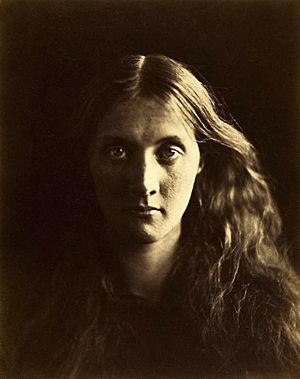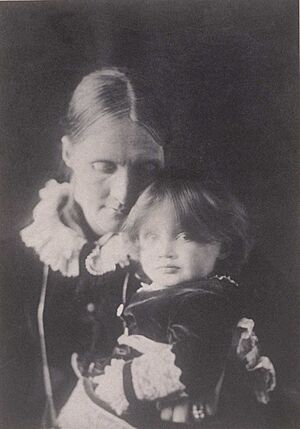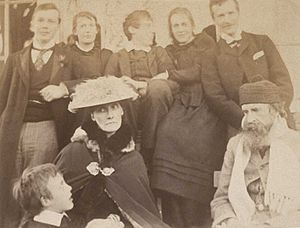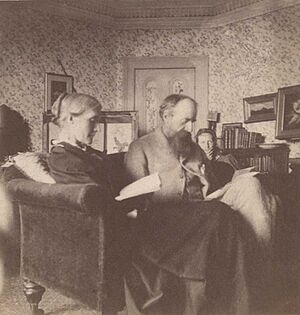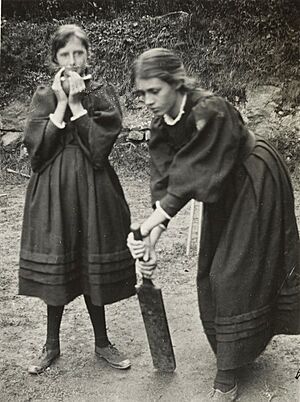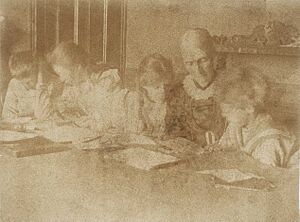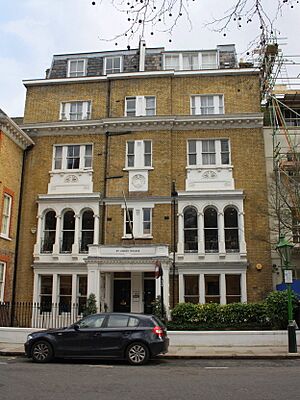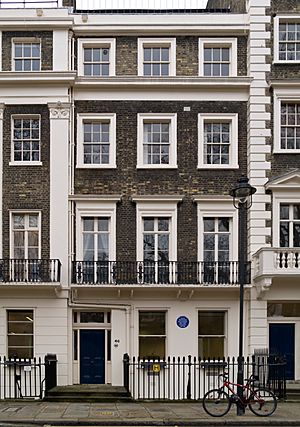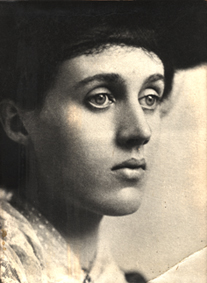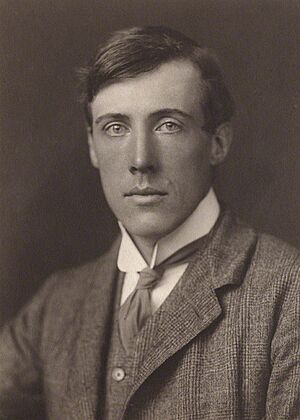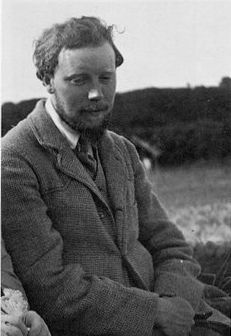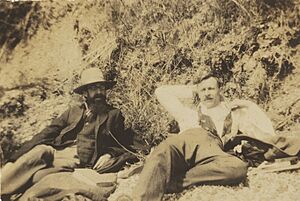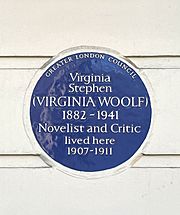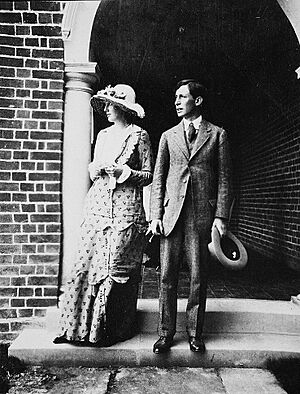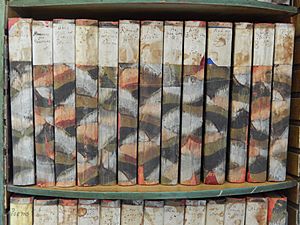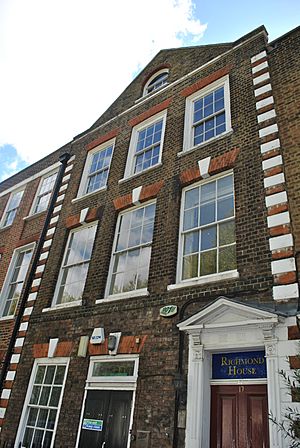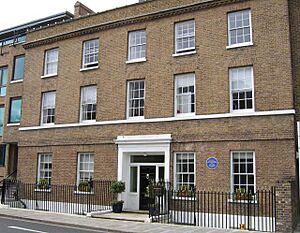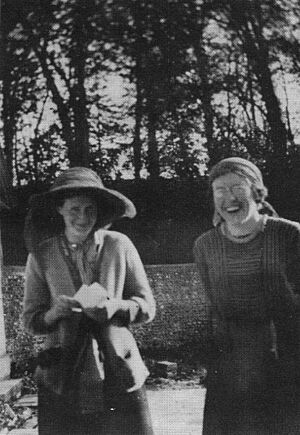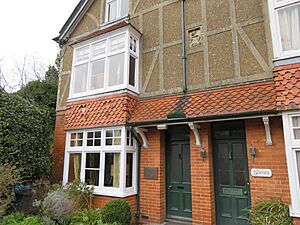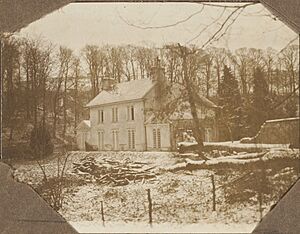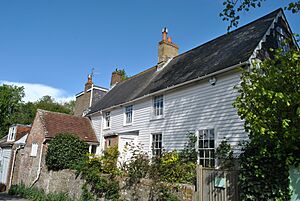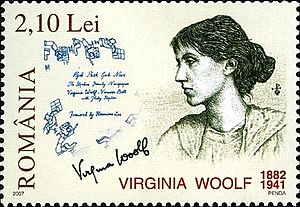Virginia Woolf facts for kids
Quick facts for kids
Virginia Woolf
|
|
|---|---|
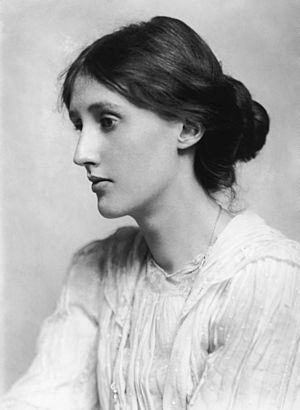
Woolf in 1902
|
|
| Born | Adeline Virginia Stephen 25 January 1882 London, England |
| Died | 28 March 1941 (aged 59) Lewes, England |
| Occupation | Novelist, essayist, publisher, critic |
| Alma mater | King's College London |
| Notable works |
|
| Spouse | |
| Parents | Leslie Stephen, Julia Prinsep Jackson |
| Relatives |
|
| Signature | |
 |
|
Adeline Virginia Woolf (born Stephen; 25 January 1882 – 28 March 1941) was an English writer. She is known as one of the most important modernist authors of the 20th century. She was also a pioneer in using stream of consciousness in her stories. This is a way of writing that shows a character's thoughts and feelings as they happen.
Virginia Woolf grew up in a well-off family in South Kensington, London. She was the seventh of eight children in a large family. Her mother was Julia Stephen and her father was Leslie Stephen. Her sister, Vanessa Bell, became a famous painter. Virginia was taught at home. She learned about English classics and Victorian literature from a young age. From 1897 to 1901, she studied classics and history at King's College London. There, she met people who were working for women's rights.
Her father encouraged her to write. Virginia began writing professionally in 1900. After her father died in 1904, her family moved to Bloomsbury. There, she and her brothers, along with their intellectual friends, formed the Bloomsbury Group. This was a group of artists and writers. In 1912, she married Leonard Woolf. In 1917, they started their own publishing company, the Hogarth Press. They published many of her books there. They also rented a home in Sussex and moved there for good in 1940. Virginia had a close friendship with writer Vita Sackville-West. Vita also published her books through Hogarth Press. Their friendship inspired both women's writing.
Between World War I and World War II, Virginia was a key part of London's literary and art scene. Her first novel, The Voyage Out, came out in 1915. Her half-brother's company published it. Her most famous novels include Mrs Dalloway (1925), To the Lighthouse (1927), and Orlando (1928). She is also known for her essays, like A Room of One's Own (1929). In the 1970s, Virginia Woolf became a central figure for feminist critics. Her works have been translated into over 50 languages. Many books, plays, and films are about her life and work. Today, statues and societies honor her. A building at the University of London is also named after her.
Throughout her life, Virginia struggled with her health. She needed special care at different times. Experts today believe she had an illness that affected her moods, similar to bipolar disorder. There was no good treatment for this during her lifetime. Virginia Woolf died in 1941, at age 59, near Lewes.
Her Early Life
Her Family
Virginia Woolf was born Adeline Virginia Stephen on January 25, 1882. She was born in London. Her parents were Julia Stephen (born Jackson) and Leslie Stephen. Her father was a writer, historian, and essayist. Her mother was born in India. Julia's family was known for their beauty. Her aunt, Julia Margaret Cameron, was a famous photographer.
Julia Jackson had been married before. Her first husband, Herbert Duckworth, died young. They had three children:
- George Herbert Duckworth (1868–1934)
- Stella Duckworth (1869–1897)
- Gerald Duckworth (1870–1937), who started a publishing company.
Leslie Stephen also had been married before. His first wife, Minny Thackeray, died in childbirth. They had one daughter, Laura (1870–1945). Laura had developmental challenges and later needed special care.
Julia Duckworth and Leslie Stephen became friends. They married in 1878. Julia was 32 and Leslie was 46. They had four children together:
- Vanessa (1879–1961), who became a painter.
- Thoby Stephen (1880–1906)
- Virginia (1882–1941)
- Adrian Stephen (1883–1948)
Growing Up in London
Virginia lived at 22 Hyde Park Gate in London until her father died in 1904. It was a tall, narrow house. The family often walked in nearby Kensington Gardens and Hyde Park.
Virginia and her sister Vanessa started a family newspaper called the Hyde Park Gate News in 1891. Virginia became the main writer. She also started her first diary in 1897.
Their home was full of famous visitors. Writers like Henry James and Thomas Hardy came to visit. This meant Virginia grew up around many important literary people.
Virginia loved to write from a young age. Her father encouraged her. She would write stories on the sofa. By age five, she was writing letters and telling her father stories every night.
Summer Holidays in Cornwall
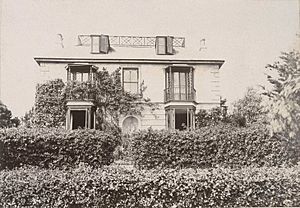
Every summer from 1882 to 1894, the Stephen family went to Talland House in St Ives, Cornwall. It was a large house with a garden overlooking the sea. Virginia could see the Godrevy Lighthouse from her window. This lighthouse later became a central part of her novel To the Lighthouse.
These summers were very important to Virginia. She wrote in her diary, "Why am I so incredibly and incurably romantic about Cornwall? One's past, I suppose; I see children running in the garden … The sound of the sea at night … almost forty years of life, all built on that, permeated by that." Cornwall inspired many of her books.

Difficult Times
Virginia's mother died in May 1895 when Virginia was 13. This was a very hard time for her. It was the start of her struggles with her health. Her half-sister Stella took care of the family. But Stella also died in 1897. Virginia called the years after her mother's death "the seven unhappy years."
Her father became ill in 1902 and died in 1904. His death caused Virginia to have another health crisis.
Her Education
In the late 1800s, boys and girls were educated differently. Boys went to schools and universities. Girls were often taught at home. Virginia's parents taught her. They had a classroom in their house. Her mother taught Latin, French, and history. Her father taught math.
Virginia also had full access to her father's large library. She read many books. She later said, "Read what you like," her father told her. This helped her read more deeply than many of her friends.
From age 15 to 19, Virginia studied at the Ladies' Department of King's College London. She took courses in Ancient Greek, Latin, German, and history. She also had private tutors. Her time at King's College connected her with women who were working to improve education for women.
Her brothers went to University of Cambridge. They introduced Virginia and Vanessa to their friends. These friends included Clive Bell, Lytton Strachey, and Leonard Woolf. This group later formed the Bloomsbury Group.
The Bloomsbury Group
Moving to Bloomsbury
After her father's death, the Stephen family wanted to leave their old home. Virginia, Vanessa, and Adrian moved to Bloomsbury in London in 1904. Bloomsbury was a more artistic and less expensive area.
In their new home at 46 Gordon Square, they started hosting gatherings. These "Thursday Club" meetings included Thoby's intellectual friends from Cambridge. This group became the core of the Bloomsbury Group. It included writers and artists who shared new ideas.
In 1905, Virginia began teaching evening classes. Vanessa started the Friday Club for art discussions. This brought new people into their group.
In 1906, Virginia faced more sadness. Her brother Thoby died from typhoid fever. Soon after, Vanessa married Clive Bell. With Vanessa married, Virginia and Adrian moved to a new home.
Fitzroy Square and the Dreadnought Hoax
In April 1907, Virginia moved to 29 Fitzroy Square. This house had once been home to writer George Bernard Shaw. Virginia and Adrian continued the Thursday Club meetings there. During this time, Virginia started writing her first novel, Melymbrosia, which later became The Voyage Out.
In 1910, Virginia took part in a famous prank called the Dreadnought hoax. She and other friends dressed up as Abyssinian (Ethiopian) royals. They tricked the Royal Navy into giving them a tour of the battleship HMS Dreadnought.
Marriage and Publishing
Marriage to Leonard Woolf
Leonard Woolf was a friend of Virginia's brother Thoby from Cambridge. Leonard met Virginia formally in 1904. He left for Sri Lanka (then Ceylon) for work. When he returned to London in 1911, he reconnected with the Bloomsbury Group.
Leonard fell in love with Virginia and proposed to her in January 1912. They married on August 10, 1912. Leonard became very aware of Virginia's delicate health. They shared a strong bond.
The Woolfs moved from central London to Richmond in 1914. In 1915, Virginia's first novel, The Voyage Out, was published.
From 1924 to 1940, the Woolfs lived at 52 Tavistock Square in Bloomsbury. They ran their publishing company, the Hogarth Press, from the basement. Virginia also had her writing room there.
The Hogarth Press
Virginia had enjoyed binding books as a hobby. In 1917, she and Leonard decided to start their own publishing company. They bought a printing press and set it up on their dining room table at Hogarth House. This was the start of the Hogarth Press.
Their first book, Two Stories, came out in July 1917. It had one short story by Virginia and one by Leonard. The books were hand-bound and had woodcut illustrations.
The Hogarth Press published Virginia's novels. It also published works by other important writers like T. S. Eliot. Virginia believed that women writers needed their own space to develop their ideas. The Hogarth Press helped create a community for writers with new viewpoints.
Virginia often helped Leonard print the books. She stopped being involved in the press in 1938. The press continued to publish books that promoted understanding between different cultures.
Friendship with Vita Sackville-West
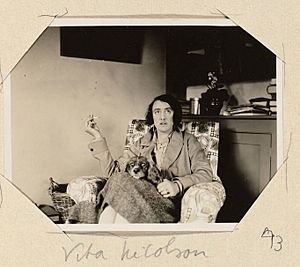
In 1922, Virginia met writer and gardener Vita Sackville-West. At the time, Vita was a more successful writer. They became close friends. This friendship was very helpful for both writers. Virginia wrote three novels during this time: To the Lighthouse (1927), Orlando (1928), and The Waves (1931).
Vita encouraged Virginia to see her writing as a strength. Virginia had been told that reading and writing were bad for her health. Vita helped her realize that writing actually helped her.
Vita chose Hogarth Press to publish her books. Her novel The Edwardians was a huge success. It sold 30,000 copies in six months. This financial success helped the Hogarth Press greatly. It also allowed Virginia to write more experimental books.
In 1928, Virginia wrote Orlando for Vita. It's a fantasy story about a nobleman who lives for centuries and changes gender. It was a playful tribute to Vita. Virginia and Vita remained friends until Virginia's death.
Life in Sussex
Virginia often needed a quiet place away from London. In 1911, she found a house to rent in Firle, Sussex. She called it 'Little Talland House', like her childhood home.
In 1912, she and Leonard found Asham House, a few miles away. It was a unique house in a quiet spot. They leased it together with Vanessa. The Woolfs spent their wedding night there. Virginia found happiness there. She wrote The Voyage Out and much of Night and Day at Asham.
In 1916, Leonard and Virginia found a farmhouse for Vanessa. This was Charleston Farmhouse. It became a summer meeting place for the Bloomsbury Group.
In 1919, the Woolfs bought Monk's House in Rodmell, Sussex. It was an old farmhouse with a large garden. It became their permanent home after their London home was bombed during World War II. Virginia lived there until her death. She finished her last novel, Between the Acts, at Monk's House.
Her Health Challenges
Virginia Woolf faced health challenges throughout her life. From age 13, after her mother died, she had periods of feeling very sad or very excited. Her family called these times her "madness."
Doctors today believe her illness was a type of bipolar disorder. This condition causes strong mood swings. Virginia was very brave and intelligent. She tried her best to understand and live with her illness.
Her mother's death in 1895 was a huge loss. It led to her first major health crisis. Her father's death in 1904 caused another serious breakdown. She even stayed in a special care facility for a short time.
Virginia found that writing helped her cope. She once said, "The only way I keep afloat... is by working... Directly I stop working I feel that I am sinking down, down."
In 1940, several things made her condition worse. Her London homes were destroyed during the Blitz. Finishing a novel often left her exhausted.
Her Death
After finishing her last novel, Between the Acts, Virginia Woolf became very sad. World War II, the bombing of her London home, and a disappointing reaction to her book about her friend Roger Fry made her feel worse.
On March 28, 1941, Virginia Woolf died by drowning in the River Ouse near her home. Her body was found on April 18. Her husband, Leonard, buried her ashes under an elm tree in their garden at Monk's House.
Her Work
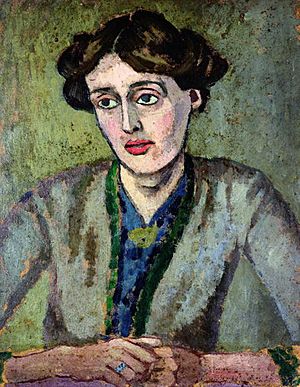
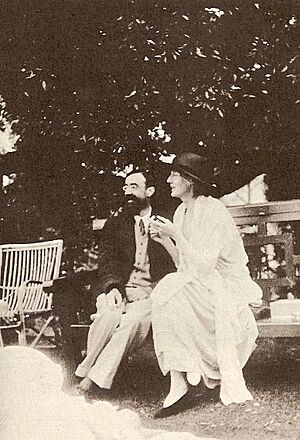
Virginia Woolf is seen as one of the most important novelists of the 20th century. She was a modernist writer. She helped pioneer the use of stream of consciousness in novels. This style shows the inner thoughts of characters.
Virginia started writing professionally in 1904. She wrote for The Guardian and The Times Literary Supplement. She published many novels and essays. Much of her work was published by her own Hogarth Press.
Her novels are very experimental. They often focus on the characters' thoughts and feelings. Her writing is known for its beautiful language and vivid descriptions.
Her Novels
- The Voyage Out (1915): This was her first novel. It tells the story of young people on a ship to South America. It hints at themes she would explore later, like how people truly feel versus what they say.
- Mrs Dalloway (1925): This novel follows Clarissa Dalloway, a woman preparing for a party. It also shows the life of Septimus Warren Smith, a soldier suffering from the effects of World War I.
- To the Lighthouse (1927): This book is set over two days, ten years apart. It focuses on the Ramsay family and their trip to a lighthouse. It explores how artists create and how time passes. It also looks at how women support men in society.
- Orlando (1928): This is one of her lighter novels. It's a funny story about a nobleman who lives for three centuries and changes from a man to a woman. It was inspired by her friend Vita Sackville-West.
- The Waves (1931): This novel follows six friends. Their thoughts and feelings are presented like waves. It reads almost like a long poem.
- Flush: A Biography (1933): This book is part fiction, part biography. It's told from the point of view of a cocker spaniel owned by the poet Elizabeth Barrett Browning.
- The Years (1936): This novel traces the history of the Pargiter family from the 1880s to the 1930s. It explores women's economic and social lives.
- Between the Acts (1941): This was her last novel. It explores themes of art, time, and life's changes. It is very poetic in its style.
Main Ideas in Her Work
Virginia Woolf's stories often explore themes like war, the effects of trauma, and social class. In Mrs Dalloway, she writes about soldiers returning from World War I with emotional scars.
She also wrote about women's roles in society. In A Room of One's Own, she suggests that women who were called "witches" in the past might have been creative geniuses who were not allowed to express themselves. She also looked at her own privileged background and how it shaped her views on class.
The sea is a common image in her work. She loved listening to the waves in Cornwall as a child. This love for the sea appears in many of her writings.
Her books have been translated into over 50 languages.
Her Plays
Virginia Woolf wrote one play called Freshwater (1935). It was based on her great-aunt, the photographer Julia Margaret Cameron. The play is a comedy that makes fun of the Victorian era. It also explores ideas about artistic freedom. It was performed once during her lifetime.
Her Essays
Virginia Woolf wrote many essays and reviews, over 500 in total. Some were long enough to be books. Many of these essays were originally lectures she gave.
A Room of One's Own
One of her most famous non-fiction works is A Room of One's Own (1929). This book-length essay is a key work of feminist literary criticism. It explores the challenges women have faced in society, education, and finance.
In it, she famously wrote, "A woman must have money and a room of her own if she is to write fiction." She looked at why women writers struggled. She compared writers like the Brontës and George Eliot to a fictional sister of Shakespeare who had genius but no opportunities. She praised Jane Austen for writing truly as a woman.
What Influenced Her
Virginia Woolf was greatly influenced by Russian literature. She admired writers like Fyodor Dostoevsky, Anton Chekhov, and Leo Tolstoy. She learned from them how to show a character's thoughts and feelings.
The American writer Henry David Thoreau also influenced her. Both Woolf and Thoreau believed that quiet time and nature could help people understand the world better. They also thought that even ordinary things could create deep emotions.
She also mentioned other writers like Daniel Defoe and Emily Brontë as influences.
Her Beliefs
Virginia Woolf spoke out on many topics. She was a strong feminist when women's rights were just starting to be recognized. She was also against colonialism and war.
Her books like A Room of One's Own (1929) and Three Guineas (1938) are important feminist works.
Her Humanist Views
Virginia Woolf grew up in a family that was not religious. Her parents were both agnostic atheists. This means they didn't believe in a specific religion. Her father was known for his writings that questioned religion.
Virginia herself said she was an atheist. She believed in doing good for the sake of goodness.
In Popular Culture
Virginia Woolf's life and work have inspired many other artists:
- The play Who's Afraid of Virginia Woolf? (1962) by Edward Albee is a famous work that references her.
- The artwork The Dinner Party (1979) by Judy Chicago includes a place setting for Woolf.
- The Bechdel test, which checks how women are shown in fiction, was inspired by Virginia Woolf's writings.
- The novel The Hours (1998) by Michael Cunningham focuses on three women whose lives are affected by Woolf's novel Mrs Dalloway. It was made into a film in 2002, starring Nicole Kidman as Virginia Woolf.
- The novels Vanessa and Virginia (2008) and Vanessa and Her Sister (2014) explore the close relationship between Virginia and her sister Vanessa Bell.
- An exhibition about Virginia Woolf was held at the National Portrait Gallery in 2014.
- The 2018 film Vita and Virginia shows the friendship between Vita Sackville-West and Virginia Woolf.
Adaptations of Her Work
Many of Virginia Woolf's works have been adapted into films and plays:
- Orlando (1928) was made into a film by Sally Potter.
- Her play Freshwater (1935) was turned into a chamber opera in 1994.
- Her short story Kew Gardens was adapted into a film segment in 2018.
- A stage play called Septimus and Clarissa was made from Mrs Dalloway in 2011.
Her Legacy
Virginia Woolf is known for her important contributions to 20th-century literature. Her essays and her influence on feminist criticism are also very important. Many authors, like Margaret Atwood and Gabriel García Márquez, have said she influenced their work.
Her image is very recognizable. More postcards of Virginia Woolf are sold by the National Portrait Gallery than any other person. You can find her image on many products.
People study Virginia Woolf all over the world. There are organizations like the Virginia Woolf Society. Trusts also encourage writers in her honor.
Monuments and Memorials
- In 2013, King's College London opened the Virginia Woolf Building. It has a plaque honoring her time there.
- Busts of Virginia Woolf have been placed at her home in Rodmell, Sussex, and in Tavistock Square, London.
- In 2014, she was honored on the Rainbow Honor Walk in San Francisco. This walk celebrates LGBTQ+ people who have made important contributions.
- A women's co-working space in Singapore, Woolf Works, was named after her in tribute to her essay A Room of One's Own.
- A campaign started in 2018 to build a statue of Woolf in Richmond, where she lived for 10 years.
Images for kids
See also
 In Spanish: Virginia Woolf para niños
In Spanish: Virginia Woolf para niños



